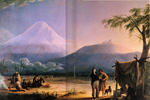Meeting 17 • 04 March 2014
|
Version: |
|
pictures of the week
|
|
|
|
mini-text of the week (start): "'…but the zambo would expect to be treated as an equal, and that I cannot do with a man of his colour.'"Humboldt, "Personal Narrative", from Jaguars and Electric Eels, ed. & trans. Wilson, pp. 47 (read more) |
|
•√ (05') Thought-bite of the week: How many "indigenous people" have you encountered, and how closely? (seen at distance, interacted with at distance, talked with [in whose language? at what level?], even more closely [combat, love?])? What defines "indigenous people"? Are you such? How long does it take to become such / American / other nationalities or peoples or cultures? Is the professor a Yankee? Are his children, born of a Southern mother, themselves Southerners? Are they still Oregonians? American subcultures, including the four from Great Britain |
|
•√ (05') New Humboldtian reading for me: A World of Rivers: Environmental Change on Ten of the World's Great Rivers, by Ellen Wohl (2011). The Amazon system; a useful graph/ table (but needs cautioun in interpreting); "one Mississippi, plus or minus"; myths about the dolphin; Altai shamans and preserving the environment from its various human threats |
|
•√ (20') More about teaching and learning. Some basic principles (student-centered, contextual, comprehensible input, spiral syllabus, function over form, encouraging inferencing and risk-taking, learner awareness of goal and standards, media-rich environment, integration of knowledge areas support of learning styles and strategies). The famous counterexample: Dickens' MR. Gradgrind (rote recitation of facts). Resources: 1) Your "My Education" assignment (standards as recipes/ inspirations; apply own experiences, good or bad - what did your teachers do right / wrong, and what should they [not] have done?). And here's a blog article, from Scientific American, that attacks state science education standards, including Oregon's, as "'mediocre to awful" - and we're not the only state or country with problems, and the other countries often cited as models (Finland!) may not be the cat's pajamas or at least not serviceable as direct models Groups report (optionally) about their projects (2' max) |
|
•+ (10') Background for Powell reading: How (and why) the US and associated territories were assessed and apportioned after the Revolutionary War (Northwest Territory / Land Ordinance of 1785, Homestead Act). The range / township / section (Public Land Survey) system (6x6, 640 / 160 (320!) / 40); improvement, revenue (schools!); USGS, Forest Service, BLM; land allocation, water and those frackin' mineral rights (implications for today's energy issues / conflicts); Oregon issues (recommended: Oregon Water, an Environmental History, by Elizabeth and William Orr, 2005). |
|
•+ (05') Sustainability of cultures and languages; reliability of data in that area compared to that of data about other species (see Ellen Wohl book menitoned above) Culture contact, "clash of civilizations", "First Encounter": culture contact and languages in SF - Damon Knight, "To Serve Man"; TR among the peoples of Humboldt-land; what if the "natives" / "local yokels" don't want to benefit from our wisdom, goodness, and wealth? what if they do? |
|
•N (10') Quick point about the Chimborazo graphic: Humboldt's pioneering work in plant (and animal) geography: the 99% perspiration and data are combined with 1% inspiration and insight to produce the monumental, iconic "Chimborazo" graphic. That was the best they had "back then" about sustainable environmentalism: the data, the thought, the presentation in words and pictures. There was NO "Big Science": no government-sponsored science (until late in 19thC in US - Powell's fights), no corporate-financed R&D. Well, there was a little, especially for military purposes (mapping, weapons). But most science was "amateur" (gentleman and a few others), because science then was not regarded as important. Producing that engraving involved huge effort and expense, even after the data was collected. –Some other "iconic" images related to science (whether as concepts or as means to deliver data effectively). –Special points: natural history collections; rarity of travel; topographic mapping (Wikipedia; Geosciences, Idaho State U) |
|
•N (05') If time (probably not): grants, jobs, résumé lines through PSU Institute for Sustainable Solutions; also PSU Student Research Symposium; also upcoming: Sustainability Celebration, 28 May; maybe a couple of our people will present their ideas; grants and conferences elsewhere; see earlier handouts for examples of internships. More soon about documenting your skills / achievements and the larger topic of employability. Want group feedback about how much to do this. "Résumé lines": "When you leave college you have to be able to list at least two things you've done that set you off from the competition" (=look good on application; topics for job/scholarship interviews) |
|
•N (05') Initial advice about "educated citizen" reading, with a short sample |
|
• Some midterms returned at end. More next meeting. |
|
• On the horizon: Soon: A last quantification activity: precise measurement of altitude / distance (demo, then do in groups). Thought questions: Are all angles and degrees created equal? Why use a barometer to measure altitude when the theodolites and trig tables are there? Margins for error in Humboldt's time and our own: latitude, longitude, altitude, temperature; news flash: PSU Building World's Biggest Barometer!! Soon: How did/do people "feel" about nature and environmentalism? (NOT expressing opinions, but rather the psychological / emotional sense, including how we can encounter their thoughts / emotions Soon: topographical mapping and iso-dimensions looking ahead: presentation of project ideas (just the ideas, not finished projects) at meeting #16 Upcoming: presentation about society back then (and any time before 1800 or so), to help understand how H related to people of other classes / races (teaser: When was it that someone's ears first popped with a change in altitude?) What/how do we FEEL about sustainable environmentalism? Not our opinions, but rather our emotions - and also how such emotions have been expressed through time and in various cultures. |

